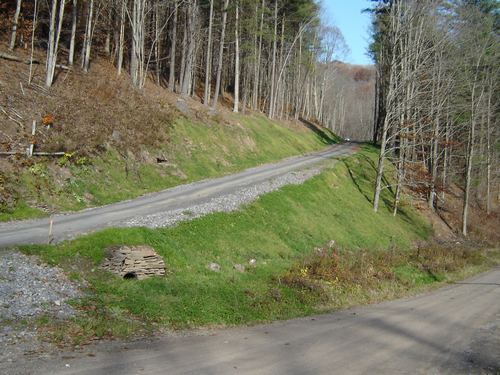DCNR Bureau of Forestry Program Overview
The PA Department of Conservation and Natural Resources administers an annual $7 million allocation through the Dirt and Gravel Road Maintenance Program. DCNR Bureau of Forestry receives approximately $3.7 million annually and dedicates this money to road projects on its 2,000+ mile network of roads that are open to public travel. The road projects funded by Forestry adhere to the Program’s Environmentally Sensitive Maintenance strategies and practices just like projects done by municipalities under the Program. A description of projects and other resources can be found in the Resources tab to the left.
Program Overview
This section covers the history, structure, project work, fund distribution, demonstration projects, and contact information.
History
Forestry was an active participant in the Dirt & Gravel Task Force in the mid 1990’s, which led to the establishment of the Dirt and Gravel Road Maintenance Program in 1997. Forestry has been a long-standing partner in the development of the Environmentally Sensitive Road Maintenance practices used in the Program. As a cooperating agency with the SCC and local County Conservation Districts, Forestry continues to work to implement pollution prevention procedures and road maintenance practices on their roads.

The PA Bureau of Forestry maintains over 2,200 miles of public roadway in 16 forest districts
Structure
The BOF Infrastructure Program Specialist, administers the program for the Bureau and is in charge of allocating the funds to the forest districts. The Infrastructure Program Specialist insures that the Forestry staff is properly trained under the same 5 year ESM training renewal format utilized by the SCC program. Over 1,000 Forestry personnel have attended an ESM training since the Program began. The Center’s responsibilities to Forestry include providing ESM training to BOF personnel, technical assistance on specific road projects, oversight of annual demonstration projects, and other general Program support. Forestry uses a Geographic Information System, similar to the DGRoads system used by Conservation Districts, to track project work. The GIS reporting system enables Forestry to inventory, prioritize, evaluate, manage and report its road maintenance activities in an automated manner.
Project Work
Forestry’s projects implement the same ESM principles and practices used by Conservation Districts on Municipal roads including pipes, underdrain, French mattresses, raising the road, Driving Surface Aggregate, road relocation, and more.
Fund Distribution
State Forest Public Roads, comprised of improved dirt and gravel surfaced roads that receive routine maintenance and are open for travel by licensed motor vehicles, are considered for Dirt & Gravel Funding. The road must have a direct impact to waters through runoff or dust. Visit the DCNR BOF DSA page for specific DSA specifications and information. All forest districts are contacted to request projects for D&G funding. After these funding requests are reviewed and revised, allocations are typically based on the miles of roads in each district, also known as the district’s “fair share”.

This forestry road in Tioga County was relocated away from a high quality stream
Demonstration Projects
Each year, one of Forestry’s biggest priorities is to fund a demonstration project to showcase some new or innovative practices on one of their roads. Forestry and Center staff work together to develop the scope of work and project location. Center staff provide oversight of project design and implementation. These projects utilize ESM techniques and procedures that are outside the realm of “normal projects”, and provide new information and educational tools for inclusion into the ESM training modules.
Past projects include:
- Several road re-locations where highly erosive roads directly adjacent to HQ and EV watersheds were moved to a more suitable location utilizing site specific ESM techniques
- Comparative analysis and cost benefit analysis of the use of limestone vs. sandstone DSA
- Sediment reduction analysis on native road surface vs. DSA surface (See “Chesapeake Bay Commission Sediment Study” under “Research“). Two separate Forestry demonstration projects have focused on turning paved roads back into gravel surfaced roadways that can be more easily and cost-effectively maintained. Mini-stabilization was utilized in the Forbes Forest district. This project is highlighted in the “Worksites in Focus – Linn Run Road”. The second project, located in the Tuscarora Forest District, utilized a modified Full Depth Reclamation procedure to return 1.5 miles of asphalt to a maintainable DSA surface.
Contacts
Ryan Ling handles the Dirt and Gravel Road Program within the PA Bureau of Forestry. While all Center staff are involved in various aspects of outreach and support to the Bureau of Forestry, Wade Brown and Dave Morrison are the Center’s “point men” on forestry issues and projects.
Ryan Ling
Infrastructure Program Specialist
PA Department of Conservation and Natural Resources
Bureau of Forestry, Division of Operations and Recreation
400 Market Street | Harrisburg, PA 17101
Mobile: (814) 592-9768
E-mail: ryling@pa.gov
Wade Brown
Field Operations Specialist
225 Transportation Research Building
University Park, PA 16802
Phone: (717) 309-2418
Fax: (814) 863-6787
E-mail: web127@psu.edu
Dave Morrison
216 Transportation Research Building
University Park, PA 16802
Phone: (814) 865-5355
Fax: (814) 863-6787
E-mail: dcm35@psu.edu





